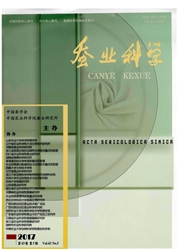

 中文摘要:
中文摘要:
柞蚕核型多角体病毒(Antheraea pernyinucleopoly hedrovirus,ApNPV)是柞蚕脓病病原,有关ApNPV的分子生物学研究可为病害综合防治提供理论依据。对ApNPVptp-1、ptp-2基因序列特性进行计算机辅助分析,并就其转录特性进行RT-PCR分析。结果表明:ApNPVptp-1、ptp-2基因均具有早期基因序列特性,但在柞蚕蛹体内这2个基因分别于感染后72、96 h开始转录,属于杆状病毒晚期基因家族。只有部分鳞翅目杆状病毒编码ptp-1、ptp-2基因同源区,非鳞翅目杆状病毒不编码ptp-1、ptp-2基因同源区,而ApNPV为鳞翅目杆状病毒,同时编码ptp-1、ptp-2基因同源区。PTP-1、PTP-2蛋白氨基酸序列中均含有双特异性蛋白磷酸酶(DSPc)结构域和酪氨酸特异性蛋白磷酸酶结构域,但在杆状病毒生命周期中,这2个蛋白是否具有相同的功能尚不清楚。
 英文摘要:
英文摘要:
Antheraea pernyi nucleopolyhedrovirus (ApNPV) is the pathogen of tussah jaundice disease, molecular biological research can provide foundation for the control of this disease. In this research, the sequence characters of ApNPV ptp-1 and ptp-2 genes were computer-assited analyzed, the transcripts were analyzed by RT-PCR . The results showed that both ApNPV ptp-1 and ptp-2 genes possessed early gene sequence characters, but transcription of the two genes was observed at 72 and 96 h post-infection ( p. i. ) in tussah pupa respectively, thus, both ptp-1 and ptp-2 belonged to baculovirus late gene family. The homologues of ptp-1 and ptp-2 genes were found in some lepidopterous baculoviruses, but not in non-lepidopterous baculoviruses. ApNPV was one of the four baculoviruses contained both ptp-1 and ptp-2 genes. The amino acid sequence of both PTP-1 and PTP-2 proteins contained dual specific protein phosphatase (DSPs) domain and tyrosine specific protein phosphatase domain. However, whether the two proteins bear the same function in baculovirus life cycle is still unclear.
 同期刊论文项目
同期刊论文项目
 同项目期刊论文
同项目期刊论文
 期刊信息
期刊信息
